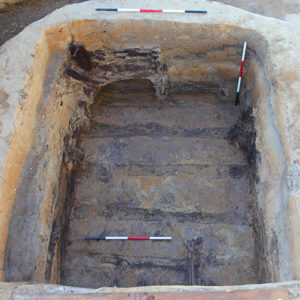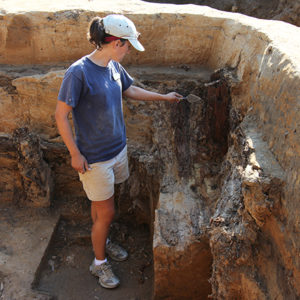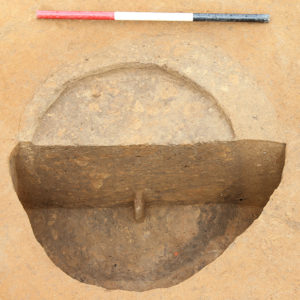Excavations have started on a 17th-century well in the southwest corner of James Fort’s 1608 church. Though the well sits inside the footprint of the church’s walls, the Jamestown Rediscovery team has been unable to date the feature yet. It is just as likely to have been constructed after the church was torn down as to have been part of the church itself. Further excavations and—hopefully—the presence of datable artifacts found within will help determine the well’s chronology. To the north and west some 50 yards and dating about 250 years later, excavations are uncovering still-extant wooden floorboards, wall posts, and roof beams to the bombproof of Confederate Fort Pocahontas. A large hollow exploded artillery shell was found in several pieces in an excavation square adjacent to the bombproof. The fragments are currently undergoing conservation for display in an exhibit on Jamestown during the Civil War. The dig on an early-fort-period mud-and-stud building in the middle of the fort is also moving forward. The wall separating the building’s two rooms has been excavated, and visiting blacksmiths from The Colonial Williamsburg Foundation have given credence to a hypothesis the Jamestown Rediscovery archaeologists have to explain two mystery postholes in the building’s east room.
The dig at James Fort’s 1608 church is focused on a neatly-circular well in the structure’s southeast corner. Almost certainly a barrel-lined well, the well’s diameter is about two-and-a-half feet. Danny Schmidt, Senior Staff Archaeologist for the Jamestown Rediscovery project, explained that a barrel well is one in which several barrels are stacked on top of one another, after first removing the top and bottom planks of each one. Excavations have progressed in removing the first two feet of soil from within the well, though Schmidt pointed out that earth removal during the construction of the Confederate earthworks and other projects since then means that these excavations have actually started approximately five feet below the well’s 17th-century ground level.
Excavations of other wells in and around James Fort have yielded many thousands of artifacts, and in comparison this well is remarkably sterile thus far. Only a few handfuls of artifacts have been recovered, and while the well’s excavation is very early in its course, archaeologists are eager to find something that will definitively tell them if the well was a feature of the church itself or if it dates to later in the 17th century and its location within the church’s bounds is coincidental (the church was torn down and replaced by another around 1617, in the same location where the 1907 Jamestown Memorial Church stands today).
Very few ceramics have been found in the well so far. Glass case bottle fragments have been found which may be significant chronologically because wine bottles widely replaced case bottles around 1650. Fragments of a Virginia Indian pipe bowl and a portion of a locally-made pipe stem were discovered inside, as was the crown of a human tooth.
Several yards away, James Fort’s western palisade wall runs right through the excavations of the bombproof of Confederate Fort Pocahontas. The archaeologists have excavated much of the soil covering the floorboards of the bombproof and have found that a substantial portion of the wood comprising the floor, and also the walls and collapsed ceiling, still survive. In an excavation area adjacent to the bombproof, 11 fragments of a hollow exploded artillery shell were found. The shell fragments will be part of an exhibit focused on Jamestown during the Civil War that will be on display in the Archaearium later this year.
Because so much of the soil that was packed on top of the bombproof’s wooden frame was dug from areas inside James Fort, excavations here continue to yield fort-period artifacts. Among them is a pig’s jaw bone, a lead runner cut from lead shot, and a handle for an early-17th-century paring knife which was typically used to remove skin from fruit. The handle is made of bone and has the likeness of two decorative leaves protruding from its sides.
Toward the middle of James Fort, archaeologists continue their work on a wonderfully-archaeologically-preserved mud-and-stud building that dates to early in the fort’s history. The building had two rooms, and the wall which divided them has just been excavated. A Border ware ceramic fragment was found during the wall’s excavation. The fragment, perhaps part of a pipkin, may be part of a broken vessel found last year in a building nearby. In the eastern room of the building there are two postholes that don’t seem to be part of the structural footprint of the structure. Because of a large amount of iron byproducts found on the floor of the building, and also because of its proximity to known metal-working buildings in this area of the fort, the archaeologists’ best guess is that these postholes may have served as support posts for a bellows used in iron production. Blacksmiths from The Colonial Williamsburg Foundation were kind enough to come take a look, and in their estimation the size of and distance between the two postholes are compatible with a bellows. We may never know the true nature of the two postholes with any certainty, but this is a good example of how archaeological evidence and consultation with experts in their fields can help us form educated guesses as to what lay above ground 400 years ago.
related images
- Conservation continues on a rapier hilt found in May inside the fort-period building in the middle of the fort.
- Overall image of Civil War bombproof
- Jamestown Rediscovery Archaeologist Mary Anna Richardson works on the wood in the Civil War bomb shelter
- The well









